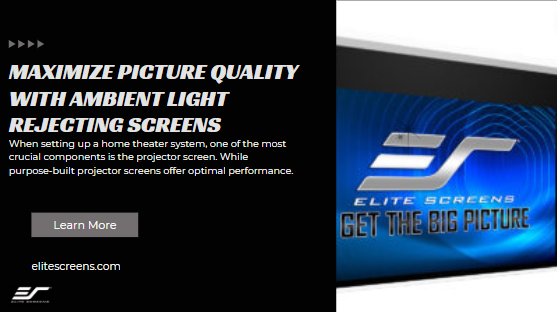
In today’s world of home entertainment and professional presentations, achieving the perfect picture quality can be a challenge, especially in environments with abundant ambient light. Enter the game-changing solution: Ambient Light Rejecting Screens. These innovative screens are revolutionizing the way we experience projected images, offering superior quality even in less-than-ideal lighting conditions. In this comprehensive guide, we’ll explore how Ambient Light Rejecting Screens can elevate your viewing experience and help you achieve stunning visuals in any setting.
Understanding Ambient Light Rejecting Screens
What are Ambient Light Rejecting Screens?
Ambient Light Rejecting Screens, often abbreviated as ALR screens, are specialized projection surfaces designed to combat the negative effects of ambient light on projected images. Unlike traditional projection screens that reflect light in all directions, ALR screens selectively reflect the projector’s light while absorbing or deflecting unwanted ambient light from other sources.
How do they work?
The magic of Ambient Light Rejecting Screens lies in their unique construction and advanced optical properties. These screens typically feature multiple layers of specialized materials, including:
- A reflective base layer
- An optical filter layer
- A light-absorbing layer
The reflective base layer is engineered to direct the projector’s light back towards the viewer, while the optical filter layer helps to enhance contrast and color saturation. The light-absorbing layer plays a crucial role in mitigating the impact of ambient light by absorbing or deflecting light coming from angles other than the projector.
Benefits of Ambient Light Rejecting Screens
Improved Contrast and Color Accuracy
One of the primary advantages of Ambient Light Rejecting Screens is their ability to maintain high contrast ratios and color accuracy, even in well-lit environments. By selectively reflecting the projector’s light and absorbing ambient light, these screens preserve the intended color and contrast of the projected image, resulting in a more vibrant and true-to-life picture.
Reduction of Ambient Light Interference
Traditional projection screens struggle in rooms with windows, overhead lighting, or other sources of ambient light. Ambient Light Rejecting Screens excel in these challenging environments by minimizing the impact of stray light. This reduction in light interference leads to sharper images, deeper blacks, and an overall enhanced viewing experience.
Enhanced Viewing Experience in Bright Environments
With an Ambient Light Rejecting Screen, you’re no longer limited to viewing projected content in dark rooms. These screens open up new possibilities for enjoying high-quality projections in living rooms, conference halls, and even outdoor settings. Whether you’re watching movies, giving presentations, or displaying digital signage, ALR screens ensure that your content looks its best, regardless of the lighting conditions.
Factors to Consider When Choosing Ambient Light Rejecting Screens
Screen Material and Coating
The effectiveness of an Ambient Light Rejecting Screen largely depends on its material composition and specialized coatings. Look for screens that feature multiple layers of optical materials designed to optimize light reflection and absorption. Some high-end ALR screens incorporate advanced nanotechnology or micro-lens arrays to further enhance their light-rejecting properties.
Viewing Angle and Screen Gain
When selecting an Ambient Light Rejecting Screen, consider the viewing angle and screen gain. The viewing angle refers to the range of positions from which the screen can be viewed without significant loss in image quality. Screens with wider viewing angles are ideal for larger audiences or rooms with varied seating arrangements.
Screen gain, measured as a ratio, indicates how much light the screen reflects compared to a standard white surface. Higher gain values result in brighter images but may also lead to a narrower viewing angle. For most Ambient Light Rejecting Screens, a gain between 0.8 and 1.3 offers a good balance between brightness and viewing angle.
Compatibility with Projector Technology
Ensure that the Ambient Light Rejecting Screen you choose is compatible with your projector technology. Some ALR screens are optimized for specific types of projectors, such as ultra-short throw or laser projectors. Matching your screen to your projector’s specifications will help you achieve the best possible image quality.
Installation and Maintenance Tips
Proper Positioning for Optimal Performance
To maximize the benefits of your Ambient Light Rejecting Screen, proper installation is crucial. Consider the following tips:
- Position the screen away from direct light sources when possible.
- Adjust the projector’s throw distance and angle according to the screen’s specifications.
- Use light-absorbing materials or curtains around the screen to further reduce ambient light.
Cleaning and Care Instructions
Maintaining your Ambient Light Rejecting Screen is essential for long-lasting performance. Follow these guidelines:
- Use a soft, lint-free microfiber cloth for gentle dusting.
- Avoid harsh chemicals or abrasive cleaning materials.
- For stubborn stains, consult the manufacturer’s cleaning recommendations.
- Handle the screen with care to prevent damage to the specialized coatings.
Real-World Applications and Success Stories
Ambient Light Rejecting Screens have found success in various settings:
- Home Theaters: Homeowners can now enjoy cinema-quality experiences without the need for complete darkness.
- Corporate Presentations: Businesses utilize ALR screens to deliver crisp, clear presentations in well-lit conference rooms.
- Education: Schools and universities benefit from improved visibility in classrooms with natural light.
- Digital Signage: Retailers and advertisers use ALR screens to display eye-catching content in bright, high-traffic areas.
One success story comes from a university lecture hall that struggled with poor projection quality due to large windows. After installing an Ambient Light Rejecting Screen, students reported significantly improved visibility and engagement during presentations.
Conclusion
Ambient Light Rejecting Screens represent a significant leap forward in projection screen technology, offering a solution to the age-old problem of ambient light interference. By understanding the science behind these screens and carefully considering factors such as material, viewing angle, and compatibility, you can dramatically enhance your viewing experience in any environment.
Whether you’re a home theater enthusiast, a business professional, or an educator, investing in an Ambient Light Rejecting Screen can transform the way you present and consume visual content. With their ability to maintain high contrast, vibrant colors, and sharp images even in challenging lighting conditions, ALR screens are an invaluable tool for anyone seeking to maximize picture quality.